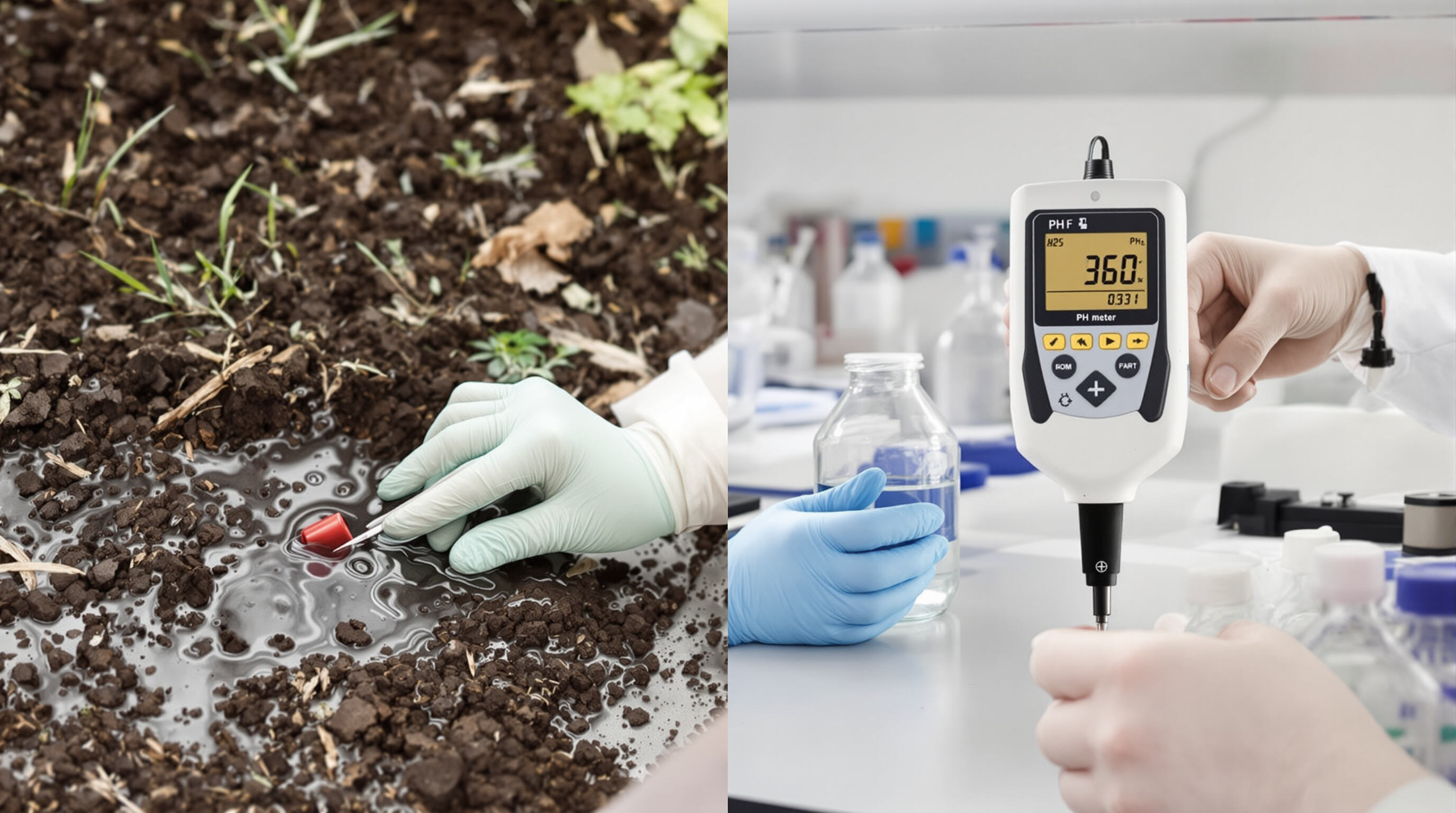Design and Build: What Defines a Portable vs. Benchtop pH Meter
Field workers love portable pH meters because they're made to move around easily. These little devices pack quite a punch despite their small size, usually weighing less than 1.5 pounds. Most come with solid build quality too, able to withstand splashes and drops thanks to those IP67 ratings and tough outer shells. Some models even have clever electrode storage solutions so technicians don't lose parts when moving between sites. On the other hand, benchtop pH meters sit nicely on lab benches where they belong. Labs often need them for handling multiple samples at once, with chamber sizes ranging from 6 up to 12 samples depending on what's needed. The best ones come equipped with special holders that keep electrodes steady during tests. Top tier models go further still, offering automatic calibration features and cleaning systems that save time when running hundreds of tests each day. This makes all the difference in busy labs where consistency matters most.
Accuracy, Precision, and Measurement Stability Compared

When it comes to precision, benchtop pH meters really stand out. These instruments can hit accuracy levels as tight as plus or minus 0.001 pH thanks to their triple point calibration system, which makes them ideal for serious work in places like pharmaceutical labs where quality control matters or during complex titration processes. The thermal stability is pretty impressive too, staying within about 0.1 degree Celsius range, so there's not much drift happening even during those lengthy experiments that take hours. Portable versions are different though. Most portable pH meters typically manage around plus or minus 0.02 pH accuracy, which works fine for basic environmental monitoring or soil testing in agriculture fields. But don't count on them holding up well when conditions change rapidly. Even with automatic temperature compensation built in, research published last year found that portable models tend to drift 2 to 3 times more than their benchtop counterparts whenever temperatures start fluctuating around them.
Power Sources, Size, and Ease of Operation Across Models
The portable versions come equipped with rechargeable lithium ion batteries that last over 500 hours, plus they support both USB C charging ports and solar panels when working away from traditional power sources. The keypad is completely waterproof so technicians can operate them one handed even while wearing protective gloves. For benchtop models, most labs stick with regular AC power but include those handy super capacitor backups to keep important data safe during unexpected power cuts. These desktop units typically feature larger screens ranging between five to seven inches across, making it easier to watch several different measurements at once. A recent industry poll found that around eight out of ten lab managers actually favor these bigger benchtop systems when they need to monitor things like pH levels, conductivity readings, and oxidation reduction potential all together because the interface feels much more intuitive and offers plenty of extra features that handhelds just don't have.
When to Use Portable pH Meters: Ideal Field Applications
Environmental Monitoring and On-Site Agricultural Testing
Portable pH meters have become pretty much necessary when it comes to checking soil and water conditions out in the field. According to AgriTech Innovations from last year, around two thirds of farmers and agronomists rely on these handheld gadgets to get instant readings of soil acidity while they're actually working the land. This lets them adjust fertilizer amounts right there during planting seasons instead of guessing later. Field scientists love them too for environmental studies. When tracking changes in rivers or streams, researchers can grab samples and test pH levels on site rather than waiting weeks for lab results that might be outdated by then. The time saved makes all the difference in understanding ecosystem health patterns as they happen.
Mobility, Ruggedness, and Water Resistance in Outdoor Use
Field-ready pH meters are designed to endure harsh conditions:
- IP67-rated waterproofing protects against rain and temporary submersion
- Drop-tested construction withstands falls from 1.5 meters onto concrete
- Ergonomic grips ensure secure handling while wearing protective gloves
A 2023 field study published in the Environmental Monitoring Journal found that ruggedized models maintained ±0.05 pH accuracy after 500 hours of continuous coastal exposure.
Battery Life and Reliability in Remote or Unpowered Locations
Today's portable devices can last anywhere from 50 to 120 hours on a single charge, and certain models that work with solar panels can basically run forever in remote locations without access to electricity. According to recent market research, around 9 out of 10 professionals need at least 72 hours of battery life when they're out in the field for a full week. Many gadgets now come with special power saving settings that keep them running in standby mode for up to a month straight. This makes all the difference when scientists or inspectors are conducting long term studies or assessments in hard to reach places where regular charging isn't possible.
When to Choose Benchtop pH Meters: Advantages in Laboratory Settings
High-Throughput Testing and Quality Control Applications
Benchtop pH meters work best in lab settings where quick, repeated testing is needed all day long. Think food safety checks or quality assurance in drug manufacturing. These instruments stay put on the bench, letting technicians run well over a hundred samples each day while reducing mistakes from manual handling. The equipment comes with handy accessories too – things like sample trays that hold multiple items at once and automatic systems that clean electrodes between tests. This kind of setup keeps results consistent across batches, something labs need to meet those strict ISO 17025 requirements and keep their regulatory approvals intact.
Superior Accuracy and Stable Performance Under Controlled Conditions
Benchtop meters used in labs can measure pH down to 0.01 units because they have reliable power sources and smart temperature compensation systems. When kept at around room temperature between 20 and 25 degrees Celsius, these instruments show minimal drift of about 0.02 pH units even after sitting for eight hours straight. That's way better than what happens with handheld devices that get affected by changes in surrounding conditions throughout the day. The accuracy matters a lot when doing things like chemical titration experiments or keeping track of bioreactors. Labs also need this kind of precision to meet those strict requirements outlined in USP chapter 791 for pharmaceutical quality control.
Advanced Data Logging, LIMS Integration, and Automation Features
Modern benchtop instruments have made things much easier for labs by connecting directly to Laboratory Information Management Systems or LIMS for short. These devices automatically send out results with timestamps and complete calibration records, making it simple to track everything back later. Many models now come with built-in Standard Operating Procedures that can be programmed, so they handle batches of tests on their own without constant supervision. The latest data from a 2023 industry survey shows around three quarters of large testing labs already use these features regularly in their daily operations.
Key Factors to Consider When Choosing a pH Meter

Matching pH Meter Type to Application: Field vs. Lab Requirements
The choice between portable and benchtop models depends on usage context. Portable meters are ideal for fieldwork, offering durability and mobility in challenging environments (2024 Water Analysis Technology Report). Benchtop units dominate in labs, where their ±0.01 pH accuracy and automation features meet the demands of high-throughput, regulated testing.
| Factor | Portable pH Meters | Benchtop pH Meters |
|---|---|---|
| Calibration Frequency | Every 7–10 field tests | Daily in continuous use |
| Environmental Resilience | Operates in -10°C to 50°C | Requires 15°C–30°C controlled labs |
| Sample Throughput | 20–30 tests/day | 100+ tests/day |
Cost, Calibration, and Long-Term Maintenance Considerations
Although portable meters have lower upfront costs ($200–$500), benchtop systems prove more economical over time for labs conducting 10,000+ annual tests. A 2023 study showed benchtop electrodes last 2.3 times longer (18 months vs. 8 months) under heavy use, reducing replacement costs by $740 per year.
Durability, Environmental Resilience, and Future-Proof Connectivity
Many modern portable meters now feature Bluetooth 5.0 for real-time data syncing—a priority for 67% of environmental scientists in a 2024 survey. In contrast, laboratory instruments increasingly emphasize LIMS integration, with 92% of FDA-compliant labs requiring auditable pH records.
Are Portable pH Meters Closing the Gap in Precision and Reliability?
High-end portable units now match benchtop performance (±0.02 pH) in 85% of freshwater field tests, according to NIST 2023 validation studies. However, under extreme conditions—such as prolonged industrial monitoring at 80°C—benchtop meters retain accuracy four times longer, highlighting their advantage in demanding, sustained applications.
Making the Right Investment: Selecting a Scalable pH Meter Solution
Evaluating Brand Options for Scalability
When looking at manufacturers, focus on those that provide scalable options with features like modular design elements, longer term service contracts, and calibration programs that handle multiple devices. Top suppliers now produce electrode systems that actually work seamlessly between portable units and benchtop equipment, which can save labs anywhere from about 22% to maybe even 35% over time when compared to those closed system approaches we see so often these days according to last year's Lab Equipment Trends report. Labs should really consider working with companies that have good local service coverage and quick access to replacement parts too, especially if there are plans for expansion down the road. Nobody wants their operations grinding to a halt because spare components take weeks to arrive from overseas.
Ensuring Compatibility With Cloud Platforms and Future Lab Upgrades
Connecting lab equipment to cloud-based LIMS systems isn't just nice to have anymore it's pretty much required if labs want to stay compliant and share data effectively. When shopping around, check for devices that offer standard API connections or Bluetooth 5.0 plus features. According to LabTech Journal from last year, most upgraded labs (around 8 out of 10) consider these connections absolutely necessary. The smarter models coming out now often come with interchangeable sensors and regular firmware updates, which keeps them working well even as the internet of things keeps changing. Labs should really think about getting instruments that have software support for at least five years minimum. Otherwise they risk ending up with outdated gear when new connectivity rules start rolling out across the industry.
FAQs about Portable and Benchtop pH Meters
What are the main differences between portable and benchtop pH meters?
Portable pH meters are designed for field use, offering mobility, durability, and resilience in outdoor conditions. Benchtop pH meters, on the other hand, are more suited for laboratory settings, providing higher accuracy and the ability to handle high sample testing volumes with automated features.
How accurate are portable pH meters compared to benchtop models?
Portable pH meters generally offer accuracy around ±0.02 pH, which is adequate for environmental monitoring. Benchtop models can achieve levels of ±0.001 pH, making them ideal for precision work such as pharmaceutical testing.
Can portable pH meters be used effectively in labs?
While portable meters can be used in labs for some applications, benchtop models are preferred due to their superior precision, stability, and extensive testing capabilities.
How does temperature affect pH meter accuracy?
Fluctuating temperatures can cause pH meters to drift. Benchtop models offer better thermal stability and are less affected by temperature changes compared to portable meters.
What should be considered when choosing a pH meter?
Consider the application, accuracy requirements, calibration needs, environmental conditions, and connectivity when selecting a pH meter. Portable models excel in fieldwork, while benchtop meters are better for lab use.
Table of Contents
- Design and Build: What Defines a Portable vs. Benchtop pH Meter
- Accuracy, Precision, and Measurement Stability Compared
- Power Sources, Size, and Ease of Operation Across Models
- When to Use Portable pH Meters: Ideal Field Applications
- When to Choose Benchtop pH Meters: Advantages in Laboratory Settings
- Key Factors to Consider When Choosing a pH Meter
- Making the Right Investment: Selecting a Scalable pH Meter Solution
- FAQs about Portable and Benchtop pH Meters

